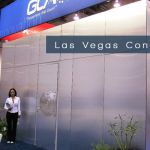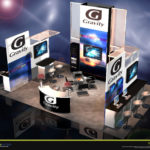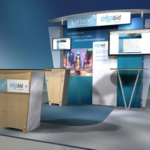Six types of Popular Trade Show Displays
This post may contain affiliate links or Google Ads and we may earn a small commission when you click on the links at no additional cost to you. As an Amazon Affiliate, we earn from qualifying purchases. This is at no additional cost to you and helps with our website expenses.
 The modern trade show is a descendant of the ancient and medieval fair at which people from different regions, with different types of goods to sell, would display their wares. There are, it must be acknowledged, numerous differences between the two that are as important as, if not more important than, the similarities. One difference, of course, is that businesses play a much bigger role in people’s lives than it did in the past, when the majority of goods for human use where made by hand and at home.
The modern trade show is a descendant of the ancient and medieval fair at which people from different regions, with different types of goods to sell, would display their wares. There are, it must be acknowledged, numerous differences between the two that are as important as, if not more important than, the similarities. One difference, of course, is that businesses play a much bigger role in people’s lives than it did in the past, when the majority of goods for human use where made by hand and at home.
The most important element of any trade show is the display. As a business owner running a trade show, you want to attract viewers from a distance and make them react to your display immediately. Described below are six types of trade show displays that you might want to consider for yours.
1) Tabletop trade show displays
A tabletop display typically consists of a metal framework that can be folded up and carried around in a case. Some have three panels, while others have a fourth that folds over the middle one. Photographs or printouts can be attached to the panels, as shown here, usually with magnets or Velcro. One advantage of these is that they are easy to set up and do not really require any assistance on-site. Some tabletop trade show displays have dry-erase boards. Tabletop displays may be small compared to other forms of display but they can really convey your message, especially if you put your ads on both sides! The show contractor usually supplies the table.
2) Banner stands
Banner stands are also lightweight and easy to carry, though they can be large: The H trade show display banner stand, for instance, is designed to hold a 24″ by 63″ banner and can be used both indoors and outdoors. It features a heavy steel base with fiberglass rods connected to it. There are also frame-based tension fabric banners, motorized scrolling banners and X banner stands.
3) Pipe and drape
A pipe and drape display typically consists of a set of metal posts, each supported by a plate and connected to the others by means of cross beams. The fabric drape, which is of either a neutral color or one that relates to the overall theme of the display, is either tied or threaded onto these beams. Pipe and drape displays are used more often as a backdrop than as part of the foreground because they are not meant to support direct weight, nor do they provide much branding or graphics. They are often supplied by the contractor and usually have a display structure, either rented or purchased, placed directly in front of them.
4) Panel and frame systems
This is one of the most complex expensive forms of display, consisting of thousands of aluminum parts and requiring for its setup on-site aid provided by a general contractor who works for the show or a labor contractor who has been approved by the management.
5) Portable displays
All of the displays described in the previous sections, with the exception of the panel and frame type, could be spoken of as portable. However, in this article a specific type, also known as the pop-up or pull-up display, will be referred to as such. A pop-up display consists of a fabric panel that winds up on an attached spring-loaded roller. It is light enough to be carried in a case. Sometimes a series of such displays is used; at other times only a single pop-up is enough to convey the company message.
6) Modular displays
A modular display is more complex than a pop-up but less so than a panel and frame system, often taking up an entire space. The structural components are usually taken from “off the shelf” and may individually be light and portable, although the whole system will require on-site aid to be set up. One of the biggest advantages of this system is that the layout can easily be changed, if necessary, from one show to another. For an example of a modular exhibit, click here.




